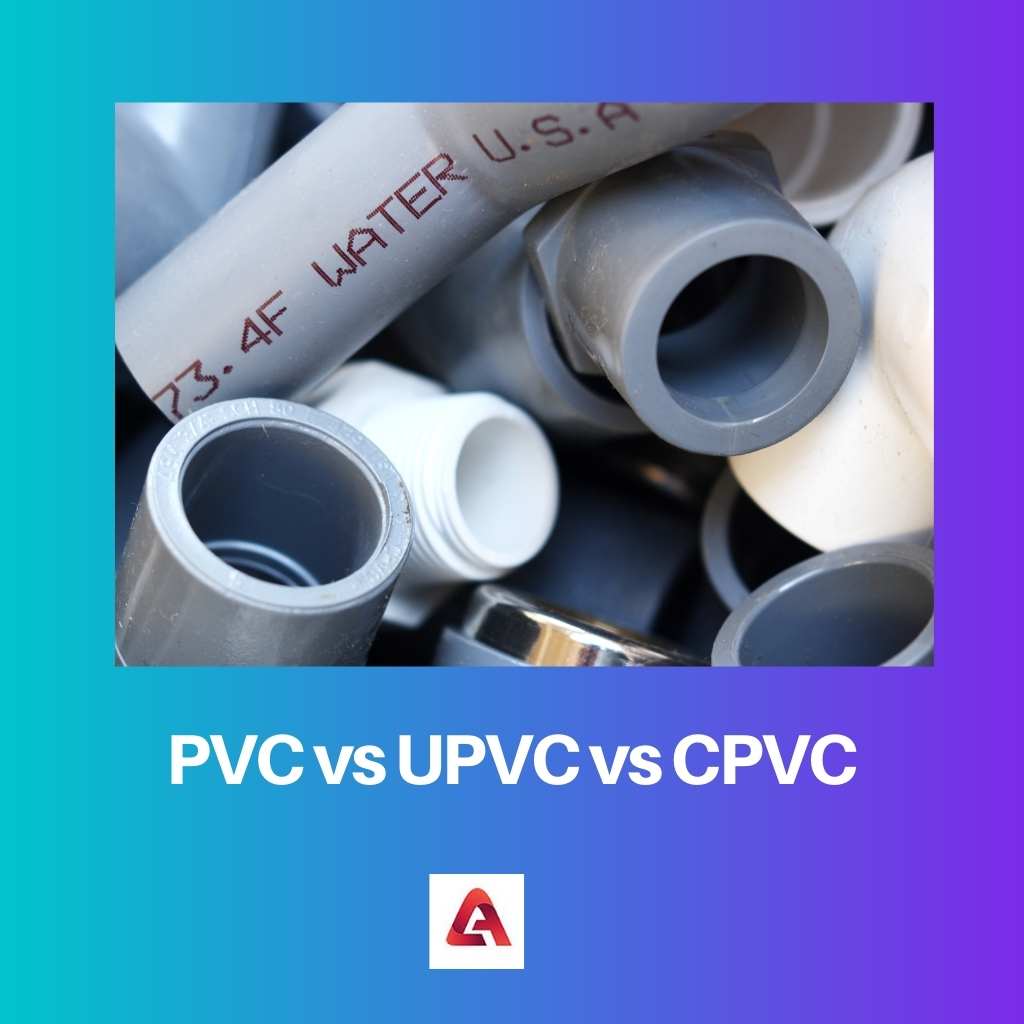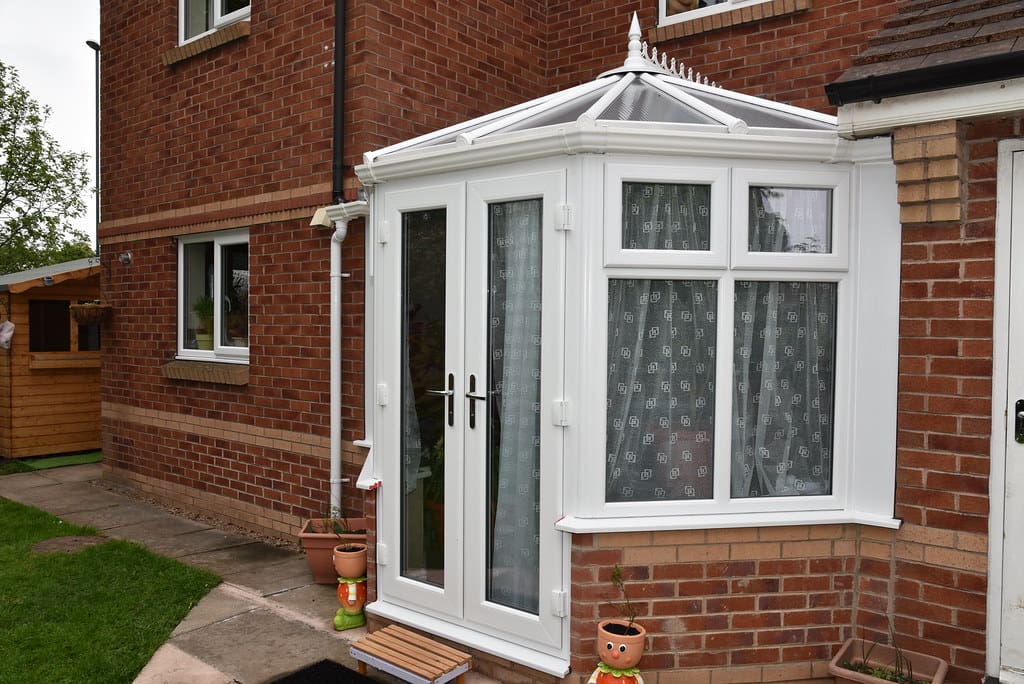PVC or Polyvinyl Chloride is a type of polymer that is mostly used in pipes, doors and windows. PVC is very popular, and globally it is the third-largest product that is made of synthetic plastic.
The demand for PVC is very much. Almost 40 million tons of PVC is produced every year. PVC is used in a lot of things like food- covering, food packaging, cards, plastic bottles etc.
PVC can be made softer by adding plasticizers to it. It makes it more flexible. UPVC and CPVC are the two forms of PVC.
Key Takeaways
- PVC (polyvinyl chloride) is a versatile plastic used in various applications, whereas uPVC (unplasticized PVC) is more rigid and used primarily for window frames and plumbing pipes.
- CPVC (chlorinated PVC) can withstand higher temperatures than PVC and uPVC, making it suitable for hot water pipes and industrial applications.
- uPVC is more environmentally friendly than PVC, as it does not contain harmful phthalates or lead.
PVC vs UPVC vs CPVC
PVC-U-P and CPVC are both types of plastic pipes used in plumbing. PVC-U is unplasticized polyvinyl chloride, rigid and strong but not as heat resistant as CPVC (chlorinated polyvinyl chloride). CPVC has a higher temperature resistance than PVC-U for hot water systems up to 60°C.

PVC comes in two forms. One is rigid, and the other is flexible. Depending upon the products they are used in. it is made softer and flexible. With the coming of PVC, it has replaced rubber in many products that were a disadvantage.
Like imitation leather, flooring, signage, plumbing, electrical cable insulation, phonograph records, inflatable products etc. A pure form of PVC is white and in solid form. It is completely insoluble in alcohol.
UPVC stands for Unplasticized Polyvinyl Chloride is a type of PVC that doesn’t include Plasticizers. Because of it, UPVC becomes more rigid and hard. UPVC is resistant to chemical damage.
UPVC is a transparent material, very tough and is resistant to all types of atmosphere or moisture. UPVC is considered good for electrical purposes. It can also be used in flammable areas because it is low flammable.
CPVC stands for Chlorinated Polyvinyl Chloride is a type of PVC that is produced by adding chlorination to Polyvinyl chloride.
CPVC has very unique features very similar to PVC. Like it is very flexible and can withstand higher temperatures. Because of chlorine present in CPVC, it is very resistant to chemicals.
So it is also considered the best product for the chemical industries as it can be used with various kinds of salts, acids and alkalis.
Comparison Table
| Parameters of Comparison | PVC | UPVC | CPVC |
|---|---|---|---|
| Full form | Polyvinyl chloride | Unplasticized polyvinyl chloride | Chlorinated polyvinyl chloride |
| Plasticizers | Composed and Uncomposed | Uncomposed | Composed |
| Rigidity | Both rigid and flexible | High rigidity | Flexible |
| Uses | Pipes, healthcare, inflatable products, cable insulation, clothes, wire rope, toys etc. | Window frames, irrigation, circulation plumbing and draining. | Hot and Cold water pipes |
| Feature | Hard, strong, elasticity, bendable, flexible, durable, low cost etc. | Rigid and durable; does not flex; safe for transporting drinking water; fire-resistant; recyclable | Temperature resistant, UV stabilization, flexible etc. |
What is PVC?
PVC was discovered in 1872 by a German chemist after he had done a lot of experimentation and investigation. PVC in its purest form is white in colour and brittle.
When Russian chemists tried to use PVC as a commercial product in the 20th century, they failed as very many difficulties came in making PVC rigid.
Then a unique method was developed in which PVC was plasticized. Thus PVC became bendable and more flexible. Now it was very easy to process them as a commercial product.
Various types of additives are used in PVC like Phthalate plasticizers, Di-2-ethyl hexyl phthalate, metal stabilizers, heat stabilizers etc.
The properties of PVC is that it contains a thermo[plastic polymer. They are both rigid as well as flexible. It is electrical, chemical, mechanical, thermal and fire-resistant.

What is UPVC?
UPVC is one of the forms of PVC. They are very rigid because plasticizers are not added to them. Hence the name is Unplasticized Polyvinyl chloride.
UPVC is mainly used in making pipes. They do not bend easily. It sometimes becomes difficult to work on them. UPVC pipes can be compared with iron pipes because of their rigid and strong properties.
UPVC pipes can be cut with power tools. They do not catch fire easily. They are very durable and also recyclable. UPVC acts as a substitute sometimes for wood in the construction areas.
Plumbing and cast iron are replaced with UPVC. One of the most important features of UPVC is that it is resistive to chemical erosion. So it is widely used in chemical industries.
UPVC is also temperature resistant. So it is used for the production of pipes. UPVC has been used indoor and windows frames because they do not change their shape and size in extreme weather conditions.

What is CPVC?
CPVC is the chlorination of Polyvinyl chloride. Because of the chlorine used in it. It becomes flexible and can withstand the temperature at a higher level.
Chlorination makes it resistive to chemicals like acids, salts and alkalis. Because of plasticizers present, CPVC becomes bendable.
CPVC can manage to carry high-temperature liquids. The purpose of CPVC is that it is mainly used in the transmission of water. That is from hot water pipes to cold water Pipes.
Some of the features of CPVC are that they are free from bacteria, safe from fire, leakproof, resistive from corrosion, can be welded etc.

Main Differences Between PVC, UPVC and CPVC
- The full form of PVC is Polyvinyl chloride. The full form of UPVC is Unplasticized polyvinyl chloride. The full form of CPVC is Chlorinated polyvinyl chloride.
- PVC can be composed and Uncomposed of Plasticizers. UPVC is Uncomposed of Plasticizers. CPVC is composed of Plasticizers.
- PVC is both flexible and rigid. UPVC has high rigidity. CPVC is flexible.
- Uses of PVC are Pipes, healthcare, inflatable products, cable insulation, clothes, wire rope, toys etc. Uses of UPVC are Window frames, irrigation, circulation plumbing and draining. Uses of CPVC are Hot and Coldwater pipe transmission.
- Features of PVC include Hard, strong, elasticity, bendable, flexible, durable, low cost etc. Features of UPVC are Rigid and durable; does not flex; is safe for transporting drinking water; is fire-resistant; recyclable. Features of CPVC are Temperature resistance, UV stabilization, flexible etc.
- https://www.researchgate.net/profile/Sadat-Rafi/publication/322385505_Design_of_a_Microcontroller_Operated_PVC_uPVC_and_CPVC_Pipe_Internal_Pressure_Test_Rig/links/5ec03b86299bf1c09ac0df12/Design-of-a-Microcontroller-Operated-PVC-uPVC-and-CPVC-Pipe-Internal-Pressure-Test-Rig.pdf
- http://www.sotech.co.kr/xeskkyqp/zzydzq-pipe-pvc47upvc47cpvc-19692789.html
